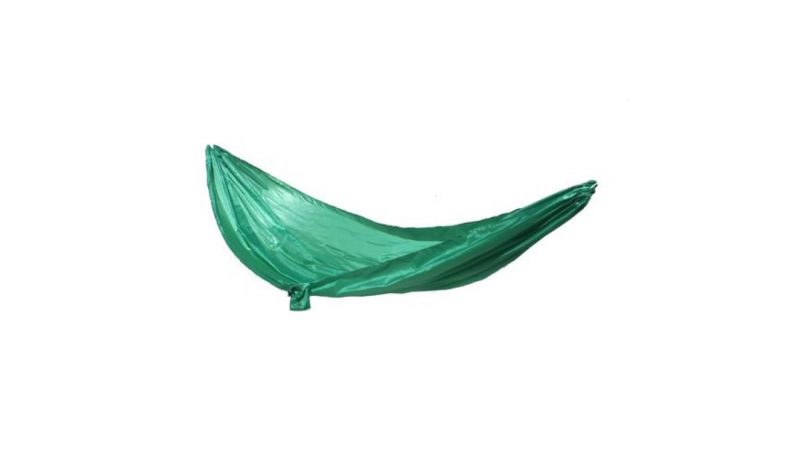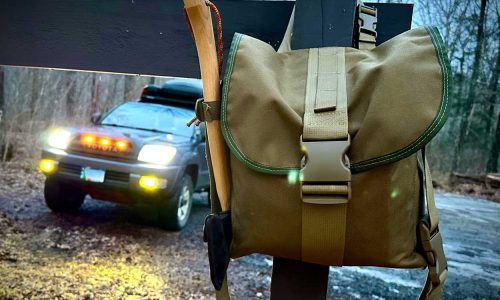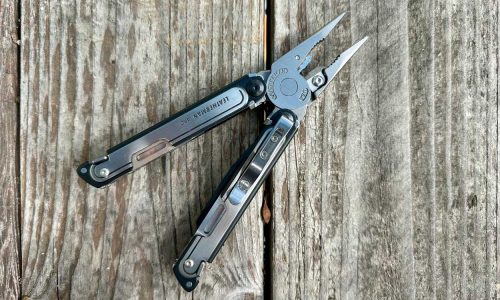Home » Gear Reviews » Hiking & Camping » Camping Hammocks » Hummingbird Single+
Hummingbird Single+ Review
January 4, 2018











 78
78 The Good
- Customizable
- Ultra lightweight
- Small packed size
- Inexpensive
The Bad
- Difficult to pack up
- Tricky suspension system
Design
The designers of the Single+ went with practicality and weight savings over comfort. The hammock is made out of a single piece of 1.1 ounce ripstop nylon. It looks thin, but it’s the same fabric that parachutes for skydivers and BASE jumpers are made out of. In fact, all of Hummingbird’s products are designed by an FAA certified parachute rigger. The stuff sack is attached in the middle, but isn’t large enough to hold much more than a deck of cards.
The fabric has a more shiny, plastic-y feel than the softer fabrics used in heavier models. It has no give and is completely windproof, as expected from parachute material. That also means it doesn’t breathe well and is more prone to slipping around in the hammock itself. We found our pillow and sleeping pads would sometimes slip out of the way overnight.
The material is gathered together tightly at both ends with Spectra cord. This narrows the ends, leaving less head and foot room. Our largest tester (6’, 200 lbs) found the Single+ to be snug—not to the point of being confining, but also not roomy enough to lay in diagonally with any comfort. The standard Hummingbird Single is 20 inches shorter, 14 inches narrower, and 2.4 ounces lighter. With a sleeping bag added, it was an even tighter fit.
Features
Hummingbird’s ultralight suspension system takes some getting used to. Instead of carabiners, each end of the hammock has a plastic button that fits through a small sewn loop. Hummingbird bills this “button link” system as “far stronger per ounce than a traditional carabiner.” The button-loop attaches to another loop on the Tree Straps ($30), which consist of 60 inches of one-inch webbing and 40 inches of 1500-lb Spectra cord. The length of the cord is adjusted with a “whoopee sling system” (these guys like their fun names) based on a Chinese-finger-puzzle knot that slides until it’s put under load, when it clinches tight.
For more length, Hummingbird sell separate extensions ($20) that offer another 72 inches of cord for an extra three-quarters of an ounce. Better yet, get the Tree Straps+ ($40), which have 120 inches of webbing each and weigh 5.5 oz together. All the cords are white, making them more visible at night.
The hexagonal Heron Tarp ($145) is made from SilPoly, or silicone-coated polyester. It feels incredibly thin, but Hummingbird says the material won’t stretch when it gets wet like silnylon can. Our testers didn’t notice either happening after camping in Oregon downpours. The tarp’s stuff sack is attached, which is a convenient touch; one less thing to lose track of. Each reinforced corner has a nylon webbing loop sewn in.
The tarp comes with a tube of Sil-Net for sealing the seams, a bit of a pain, but even more annoying is having to buy a separate guyline kit ($40). This comes with 80 feet of reflective Spectra cord (that needs to be cut and attached) and four titanium stakes and eight glow-in-the-dark plastic friction adjusters. Ultralight aficionados may enjoy customizing their setup down to the last tenth of an ounce, but the rest of us would prefer things to be ready to go out of the box.
Ease of Use
The knot-and-loop-based suspension system is not as simple as a daisy chain and carabiner, but it gets easier after a few tries, and is micro-adjustable in terms of length. You’ll probably need the extensions if you don’t get the Tree Straps+.
It’s hard to get the Single+ back into its attached sack, to the point that testers wanted to stop trying. The Heron Tarp is marginally easier, but users have to supply their own bag for the tree straps, extensions, and guyline kit. Better yet, just get one that fits everything.
Quality
The materials in the Single+ and its tarp and straps are obviously thinner than those in non-ultralight models, which makes them more prone to nicks and abrasions from normal use. A few small holes showed up after extended use, just from brushing up against sharp twigs or getting stepped on. But that doesn’t mean the system is any less strong overall: the hammock material has a tensile strength of 50 pounds per square inch and the Spectra cord is rated to 1,500 pounds. The Single+ has a row of double stitching along its edge seams, using a parachute-quality stitching pattern that won’t unravel even if part of it is compromised.
Weight
Now the good news: the Single+ was the second-lightest hammock in the test, and the lightest one our testers would consider spending a non-emergency night in. Together with the tree straps, rain tarp, and guylines, it was the lightest full system, coming in a less than some hammocks weighed alone.
Over the course of a few weeks, our testers spent multiple nights in each model, using the same sleeping bag, pad and inflatable pillow. Since the testing was based in Oregon, about half the nights involved precipitation of some kind. Each model was set up and stowed in each combination multiple times, on trees of varying diameters and distances. If a model is described as fitting two people, a companion was enlisted to check fit.
Runner, cyclist, father, writer—Julian Smith is a guy with a lot in tow, and a lot to say about the best running strollers and trailers for active parents wth kids.



















No reviews have been posted for this product.
Use this gear?
Join Gear Nation and leave a review!
Create an Account